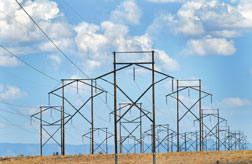NEWS RELEASES
FOR IMMEDIATE RELEASE
July 10, 2006
Sandia applies a surety approach in creating solutions to energy challenges
Energy: It’s everywhere, but we must get better at harnessing it
 Sandia applies a surety approach in creating solutions
to energy challenges. (Photo by Randy Montoya)
Sandia applies a surety approach in creating solutions
to energy challenges. (Photo by Randy Montoya)Download 300dpi JPEG image, “powerlines.jpg,” 516K (Media are welcome to download/publish this image with related news stories.)
ALBUQUERQUE, N.M. — With concerns that energy use will rapidly increase over the next several years while fossil fuels diminish, Sandia National Laboratories is looking at a new way to meet growing energy challenges — energy surety.
“We have taken our surety know-how and applied it to energy,” says Rush Robinett, senior manager of Sandia’s Energy and Infrastructure Futures Group. “By doing this we are looking at what energy practices can best answer our current needs while not making compromises for future generations.”
Robinett, together with Margie Tatro, director of Energy, Infrastructure & Knowledge Systems Center, and others in the center designed the new model and detailed it in a recently-released internal SAND report, Toward an Energy Surety Future.
Energy surety takes an integrated approach to achieving safety, security, reliability, recoverability and sustainability objectives for the nation’s civilian and military energy systems. Patterned after Sandia’s many decades of applying surety principles to weapon systems, the approach includes choosing the best mix of fuels and applying conservation principles to all steps, starting with energy production and ending with final use, even using what would normally be characterized as waste heat and mass.
Tatro notes that in developing the energy surety approach, “the sustainability model was the most difficult to create because sustainability was not a system requirement in the original weapons system surety approach.”
Sandia is a National Nuclear Security Administration laboratory.
The energy surety approach is part of Sandia’s effort to support the Department of Energy’s National Energy Policy goals, which include diversifying the country’s energy mix and reducing dependence on foreign petroleum; reducing greenhouse gas emissions and other environmental impacts; creating a more flexible, more reliable, and higher-capacity US energy infrastructure; and improving efficiency and productivity.
For the past 100 years this country has been largely dependent on liquid fossil fuels — especially petroleum — for transportation, electricity, and even food production.
Today, with the price of oil becoming unpredictable, together with increased energy consumption worldwide — particularly in China and India — and oil being concentrated in volatile countries, it’s time to manage our fuels better, Robinett says.
“Energy is all around us — just look at the power of hurricanes and tsunamis,” Robinett adds. “It’s not the lack of energy that’s the problem, it’s a knowledge shortage of how to manage and harness that energy. We believe the energy surety approach is the best way to do this. If we don’t follow this model, the whole world, including the U.S., could find itself living a lifestyle of the Third World.”
The SAND report outlines a three-step strategy for moving toward better matching of energy resources with energy needs.
The first step is to squeeze every unit of available energy from the current supplies. This goes beyond the implementation of higher-efficiency electricity-consuming devices (lighting, appliances, and motors) and vehicles (diesels and hybrids) to include waste-to-energy options such as the extraction of methane from landfills and the conversion of biomass wastes to liquid fuels. Making better use of limited fossil supplies will allow the country to “buy time” while it moves down the path towards energy surety, Tatro says.
Holding the world’s population to a level that the earth can sustain and capping energy demand at some point are also parts of step one. To address demand, consumer needs for energy must be reduced. The traditional view of an expanding world population and economy must level off or it could surge to the point of “resource exhaustion, social upheaval, disease epidemic, and then collapse,” notes the SAND report. An ultimate plan must have some commitment to hold growing populations in check.
A final part of the initial step is to limit the use of fossil fuel resources — although the magnitude of potentially recoverable fossil fuels may never be known. Conservation must be a major part of the surety plan.
The second step involves storing energy for later use when there is no wind, the sun is obscured, or an energy supply is disrupted. Currently, energy storage techniques are used in limited ways, ranging from battery-powered units to managing brief interruptions to the Strategic Petroleum Reserve. Examples that could provide expanded energy storage include solar production of hydrogen for fuel cells, solar-powered conversion of carbon dioxide and water to liquid fuels, and energy storage from solar thermal collectors.
Step three is to learn how to reproduce the sun’s fusion process on earth in a safe, secure, reliable, and sustainable way. “Though we do not know if fusion can succeed as a practical terrestrial energy source, we believe that its promise is worth extensive investment,” the SAND report says.
“While it might not be possible to fully accomplish all the goals in the energy surety model, striving toward them is far better than blindly marching toward energy depletion, environmental exhaustion, and esthetic despair, only to discover that the scarce remaining resources are inadequate to meet needs,” Robinett says. “The big question now is how to make this happen in the real world. The driver may very well be people’s pocketbooks, caused by highly unpredictable fuel prices, coupled with increasing threats of terrorism.”
Sandia is a multiprogram laboratory operated by Sandia Corporation, a Lockheed Martin company, for the U.S. Department of Energy’s National Nuclear Security Administration. Sandia has major R&D responsibilities in national security, energy and environmental technologies, and economic competitiveness.
Sandia news media contact: Chris Burroughs, coburro@sandia.gov, (505) 844-0948